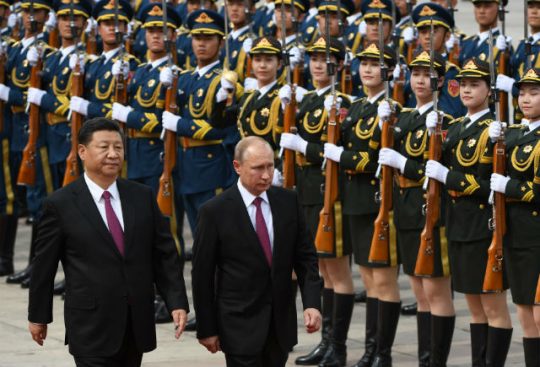President Donald Trump's National Security Strategy describes China and Russia in similar terms. "Three main sets of challengers—the revisionist powers of China and Russia, the rogue states of Iran and North Korea, and transnational threat organizations, particularly jihadist terrorist groups—are actively competing against the United States and our allies and partners," the document states. "China and Russia want to shape a world antithetical to U.S. values and interests."
The Trump administration's National Defense Strategy does the same. "The central challenge to U.S. prosperity and security is the reemergence of long-term, strategic competition by what the National Security Strategy classifies as revisionist powers," the document reads. "It is increasingly clear that China and Russia want to shape a world consistent with their authoritarian model—gaining veto authority over other nations' economic, diplomatic, and security decisions."
The White House and Pentagon are not alone. Countless experts and commentators group Beijing and Moscow together when describing the return of competition between great powers, states with the ability to wield influence on a global scale.
It makes sense why. A triumvirate dominates great-power competition: China, Russia, and the United States, and only one is a democratic outlier. China and Russia, meanwhile, are both authoritarian states looking to undermine Washington however possible, and to recapture imperial glory of an older time. They are also the only countries that could destroy the United States with thermonuclear weapons.
Yet, despite these similarities, Beijing and Moscow pose distinct challenges to the United States. This distinction is critical to recognize, with important implications for American foreign policy. The RAND Corporation, a nonprofit research organization, makes this point in a new report, which explains that, while Russia is more belligerent and an immediate threat to the United States, China poses a greater challenge in the long run and is harder to counter.
"Russia is not a peer or near-peer competitor but rather a well-armed rogue state that seeks to subvert an international order it can never hope to dominate," write James Dobbins, Howard Shatz, and Suhail Ali Wyne, the report's authors. "In contrast, China is a peer competitor that wants to shape an international order that it can aspire to dominate."
That is the crucial difference: While China is effectively of equal standing with the United States, Russia is more appropriately grouped with Iran and North Korea as a hostile, rogue state, albeit one with the world's largest arsenal of nuclear weapons in the world's largest country by landmass. More than a matter of semantics, recognizing this difference is the first step to understanding the distinct nature of the threat that each country poses—a prerequisite for creating policies to counter Beijing and Moscow's aggression.
"The figures underscore the discrepancy between Russia and China as global competitors of the United States," the report states, detailing how China's projections for population decline and economic growth are more favorable than those of Russia. There really is no comparison: China is more powerful than Russia.
"Russia, nevertheless, is a more immediate and more proximate military threat than China," the report explains. "Vladimir Putin is an opportunistic risk taker, whereas China's post-Mao leaders have proceeded cautiously and gradually to expand their country's influence."
RAND's experts also write that, while the United States can control the challenge from Russia, it cannot control the challenge from China. "Russia can be contained, employing updated versions of defense, deterrence, information operations, and alliance relationships that held the Soviet Union at bay for half a century," the report states. "China cannot be contained. Its military predominance in east Asia will grow over time, compelling the United States to accept greater costs and risks just to secure existing commitments."
"But it is geoeconomics, rather than geopolitics, in which the contest for world leadership will play out," the report adds. "It is in this former domain that the balance of global influence between the United States and China has begun shifting in China's favor."
Many of the above points are true, but one problem with the RAND report is that its authors, like so many commentators, describe China as an unbeatable giant, destined to overwhelm the United States. There is little debate that Beijing is closing the gap both militarily and economically, but there are major issues within China that, coupled with the enduring strengths of the United States, make it hard to see Chinese supremacy becoming reality. As Robert D. Kaplan told me in 2016, "The last 30 years in Chinese domestic history were far more stable than the next 30 years are going to be." Indeed, the Chinese government fears its own people, hence its efforts to implement a dystopian surveillance state. China's economy is slowing, with India's on pace to surpass it in the coming years, according to some estimates. China's population is also aging, and it has significantly less technical expertise. There is a reason why the Chinese try to steal American intellectual property, rather than create. Moreover, America enjoys its greatest strategic advantage, a great wall of allies, containing Chinese expansion in the western Pacific. These are just a few of the reasons not to be too bullish about China's rise.
Perhaps the real challenge for the United States going forward is not to manage China's rise, but to manage its fall, hopefully steering it away from desperate belligerence.
